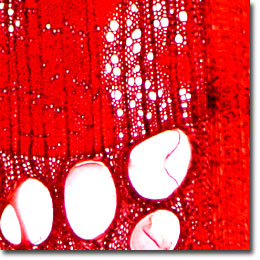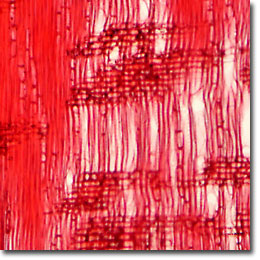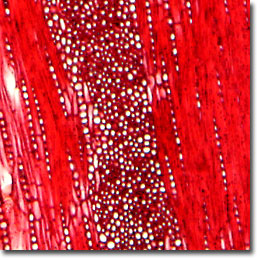The White Oak
The White Oak (Quercus alba) tree is a hardwood found primarily throughout the eastern half of the United States and Canada. This tree usually only grows to heights of 100 feet, but the branches can spread to over 150 feet when the tree is grown in open pastures. Sapwood from the white oak is white to light brown in color, while the heartwood is a rich light yellow to dark brown.

Cross Section

Radial Section

Tangential Section
The trunk of the slow growing, deciduous white oak is covered with ash-gray bark and frequently reaches 4 to 5 feet in diameter. Propagation is by seed and the tree prefers deep, well-drained soil but will grow in just about any type of soil. Leaves contain five to nine lobes and are broadest at the tip. In the fall the white oak's leaf color varies from brownish to purple.
Oaks are generally considered some of the finest hardwood timber trees and the cadre of over 450 species also includes ornamentals that decorate lawns, parks, and streets. A majority of the species are evergreen, especially the Asiatic varieties, and the group as a whole falls just short of being evergreen in North America. In fact, many of the American species have leaves that are usually withered, but persist over most of the winter.
The U.S.S. Constitution, made with the wood of the white oak, was called "Old Ironsides" because cannonballs were rumored to bounce off the ship's strong wood siding. White oak wood is widely used for flooring, farm (non-motor) vehicles, mill products (sash, doors, trim, wainscoting, general millwork), furniture (especially desks and tables, chairs, frames for upholstered furniture), kitchen cabinets, fixtures, railroad cars, boxes, crates, and pallets.
Microscopic examination of iron-alum hematoxylin and safranin stained thin sections (see the digital images presented above) reveals a porous wood, with vessels that are often occluded with tyloses. Perforation plates are simple and parenchyma is abundant. The broad rays range from 12 to 30 seriate while the narrow rays are uniseriate. Fibers libriform and fiber tracheids are medium to thick-walled, frequently gelatinous, and fine to medium in texture.